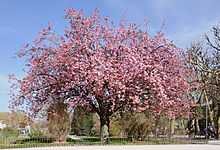Blossom

| Look up blossom in Wiktionary, the free dictionary. |
In botany, blossom is a term given to the flowers of stone fruit trees (genus Prunus) and of some other plants with a similar appearance that flower profusely for a period of time in spring. Colloquially flowers of orange are referred to as such as well. Peach blossoms (including nectarine), most cherry blossoms, and some almond blossoms are usually pink. Plum blossoms, apple blossoms, orange blossoms, some cherry blossoms, and most almond blossoms are white.[1]
Blossoms provide pollen to pollinators such as bees, and initiate cross-pollination necessary for the trees to reproduce by producing fruit.[2]
Blossom trees have a tendency to lose their flower petals in wind-blown cascades, often covering the surrounding ground in petals. This attribute tends to distinguish blossom trees from other flowering trees.
Medicinal uses
The ancient Phoenicians used almond blossoms with honey as a tonic, and sprinkled them into stews and gruels to give muscular strength. Crushed petals were also used as a poultice on skin spots and mixed with oil, for dry skin and sunburn. Crushed petals on an insect bite will soothe and a tea made from whole flowers clears up mouth ulcers and swollen gums.[3]
Originating in China and south east Asia, the earliest orange species moved westwards via the trade routes. Orange blossom has been found to be sedative, antispasmodic, and was used as a remedy for depression, anxiety, nervous debility, and insomnia.[4] A tea infusion made from orange blossoms is also used for mild stomach upset and as an aid to digestion.[5]
In 17th century Italy peach blossoms were made into a poultice for bruises, rashes, eczema, grazes and stings. Tea made from the blossoms or leaves can be used as a detoxifier, easing kidney ailments and urinary infections and clear the body of toxins.[6]
In ancient Greek medicine plum blossoms were used to treat bleeding gums, mouth ulcers and tighten loose teeth. Plum blossoms mixed with sage leaves and flowers were used in plum wine or plum brandy as a mouthwash to soothe sore throats and mouth ailments and sweeten bad breath.[7]
Gallery
-
Apple blossoms in full bloom.
-

Pear blossoms in full bloom.
-

Double-flowered Cherry Blossoms.
-

Cherry tree blossoms
-
Cherry blossoms
References
- ↑ Anna-Louise Taylor; Ben Aviss (13 March 2012). "What is Britain's best blossom?". BBC Nature.
- ↑ Colby Eierman (2012). Fruit Trees in Small Spaces. Timber Press. p. 29. ISBN 978-1-60469-190-0.
- ↑ Margaret Roberts (2000). Edible & Medicinal Flowers. Interpak Books. p. 2. ISBN 978-0-86486-467-3.
- ↑ Margaret Roberts (2000). Edible & Medicinal Flowers. Interpak Books. p. 57. ISBN 978-0-86486-467-3.
- ↑ Armando Gonzalez Stuart P.h.D (2003). "Orange Blossom" (PDF). Herbal Safety.
- ↑ Margaret Roberts (2000). Edible & Medicinal Flowers. Interpak Books. p. 59. ISBN 978-0-86486-467-3.
- ↑ Margaret Roberts (2000). Edible & Medicinal Flowers. Interpak Books. p. 62. ISBN 978-0-86486-467-3.
External links
| Wikimedia Commons has media related to Blossoms. |
- Millais' renowned painting 'Apple blossoms' at the Lady Lever Art Gallery
- BBC Nature - In Pictures: Your blossoming spring

